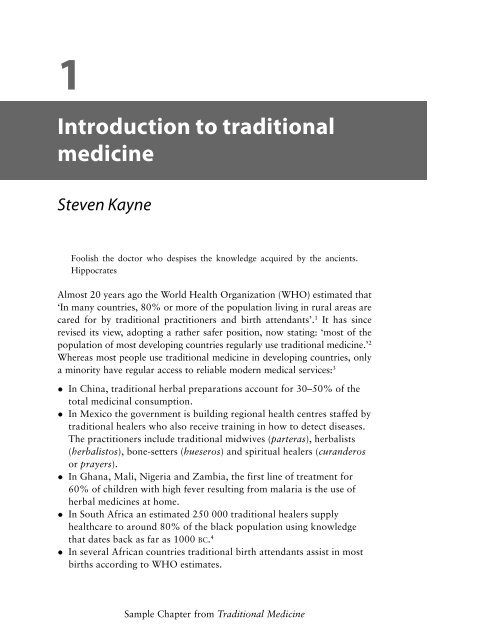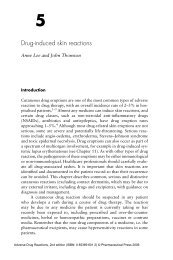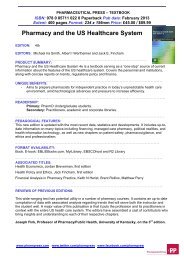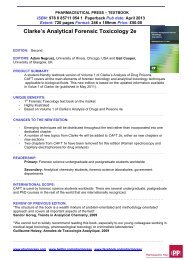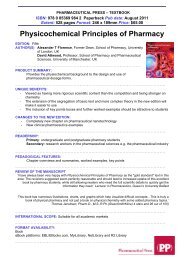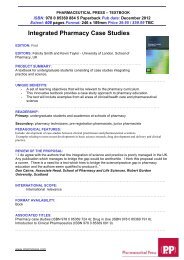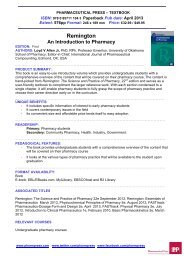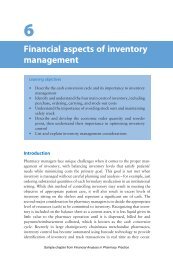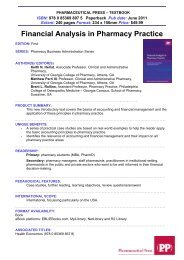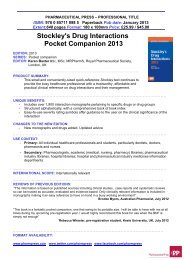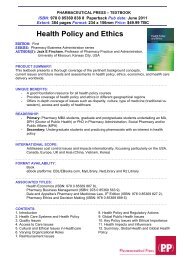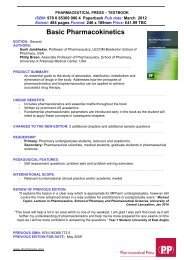1 Introduction to traditional medicine - Pharmaceutical Press
1 Introduction to traditional medicine - Pharmaceutical Press
1 Introduction to traditional medicine - Pharmaceutical Press
Create successful ePaper yourself
Turn your PDF publications into a flip-book with our unique Google optimized e-Paper software.
1 <strong>Introduction</strong> <strong>to</strong> <strong>traditional</strong><br />
<strong>medicine</strong><br />
Steven Kayne<br />
Foolish the doc<strong>to</strong>r who despises the knowledge acquired by the ancients.<br />
Hippocrates<br />
Almost 20 years ago the World Health Organization (WHO) estimated that<br />
‘In many countries, 80% or more of the population living in rural areas are<br />
cared for by <strong>traditional</strong> practitioners and birth attendants’. 1 It has since<br />
revised its view, adopting a rather safer position, now stating: ‘most of the<br />
population of most developing countries regularly use <strong>traditional</strong> <strong>medicine</strong>.’ 2<br />
Whereas most people use <strong>traditional</strong> <strong>medicine</strong> in developing countries, only<br />
a minority have regular access <strong>to</strong> reliable modern medical services: 3<br />
• In China, <strong>traditional</strong> herbal preparations account for 30–50% of the<br />
<strong>to</strong>tal medicinal consumption.<br />
• In Mexico the government is building regional health centres staffed by<br />
<strong>traditional</strong> healers who also receive training in how <strong>to</strong> detect diseases.<br />
The practitioners include <strong>traditional</strong> midwives (parteras), herbalists<br />
(herbalis<strong>to</strong>s), bone-setters (hueseros) and spiritual healers (curanderos<br />
or prayers).<br />
• In Ghana, Mali, Nigeria and Zambia, the first line of treatment for<br />
60% of children with high fever resulting from malaria is the use of<br />
herbal <strong>medicine</strong>s at home.<br />
• In South Africa an estimated 250 000 <strong>traditional</strong> healers supply<br />
healthcare <strong>to</strong> around 80% of the black population using knowledge<br />
that dates back as far as 1000 BC. 4<br />
• In several African countries <strong>traditional</strong> birth attendants assist in most<br />
births according <strong>to</strong> WHO estimates.<br />
Sample Chapter from Traditional Medicine
2 | Traditional <strong>medicine</strong><br />
• In industrialised nations some <strong>traditional</strong> therapies, in particular<br />
<strong>traditional</strong> Chinese <strong>medicine</strong>, and ayurveda, have become popular,<br />
diffusing out from immigrants in<strong>to</strong> the host community.<br />
Countries in Africa, Asia and Latin America use <strong>traditional</strong> <strong>medicine</strong> <strong>to</strong><br />
help meet some of their primary healthcare needs. In Africa, up <strong>to</strong> 80% of the<br />
population use <strong>traditional</strong> <strong>medicine</strong> for primary healthcare. Over one-third of<br />
the population in developing countries lack access <strong>to</strong> essential <strong>medicine</strong>s.<br />
Figure 1.1 shows the global distribution of <strong>traditional</strong> <strong>medicine</strong>, indicating<br />
which countries have specific policies as <strong>to</strong> its practice.<br />
The provision of safe and effective <strong>traditional</strong> <strong>medicine</strong> therapies could<br />
become a critical <strong>to</strong>ol <strong>to</strong> increase access <strong>to</strong> healthcare. In 2004 the South<br />
African Health Minister, Man<strong>to</strong> Tshabalala-Msimang, suggested that the<br />
use of African <strong>traditional</strong> <strong>medicine</strong>s may eventually replace antiretrovirals<br />
in the treatment of HIV and AIDS.<br />
In a number of industrialised countries many people regularly use some<br />
form of <strong>traditional</strong> complementary and alternative <strong>medicine</strong> (TCAM) with<br />
Germany (75%), 5 Canada (70%) 6 and England (47%) 7 being examples.<br />
Definition<br />
The WHO defines TCAM as referring <strong>to</strong> health practices, approaches,<br />
knowledge and beliefs incorporating plant-, animal- and mineral-based<br />
No policy or legislation<br />
Status<br />
Legislation pending<br />
Legislation only<br />
National policy<br />
No data<br />
Figure 1.1 The global distribution of <strong>traditional</strong> <strong>medicine</strong>, indicating which countries have<br />
specific policies as <strong>to</strong> its practice. (Adapted from WHO Global Atlas of Traditional, Complementary<br />
and Alternative Medicine, Map Volume. Kobe, Japan: WHO Centre for Health Development, 2005: 49.)<br />
Sample Chapter from Traditional Medicine
<strong>Introduction</strong> <strong>to</strong> <strong>traditional</strong> <strong>medicine</strong> | 3<br />
<strong>medicine</strong>s, spiritual therapies, manual techniques and exercises, applied<br />
singularly or in combination <strong>to</strong> treat, diagnose and prevent illnesses or<br />
maintain well-being. 2<br />
This definition makes no mention of the fact that the term ‘<strong>traditional</strong><br />
<strong>medicine</strong>’ differs from other types of complementary and alternative <strong>medicine</strong><br />
in that it is usually considered <strong>to</strong> be associated with discrete populations or<br />
geographical locations.<br />
In this book the term ‘<strong>traditional</strong> <strong>medicine</strong>’ is used <strong>to</strong> describe:<br />
Health traditions originating in a particular geographic area or ethnic group<br />
and which may also have been adopted and/or modified by communities<br />
elsewhere.<br />
Disciplines such as aromatherapy, medical herbalism, homoeopathy<br />
and others, usually known collectively as complementary and alternative<br />
<strong>medicine</strong>, are described in detail in a companion volume. 8<br />
The major <strong>traditional</strong> healing systems that have survived the impact of<br />
modern bio<strong>medicine</strong> driven by germ theory are <strong>traditional</strong> Chinese <strong>medicine</strong><br />
and its associated therapies (see Chapter 6), Indian systems of <strong>medicine</strong> (see<br />
Chapter 7) and <strong>traditional</strong> African <strong>medicine</strong> (see Chapter 5). 9 The last<br />
differs from the two Asian systems in that it is largely an oral tradition with<br />
no written records whereas the Asian systems have written philosophies and<br />
pharmacopoeias.<br />
The distinction between <strong>traditional</strong> <strong>medicine</strong> and what is known as folk<br />
<strong>medicine</strong> is not clear cut and the terms are often used interchangeably. Folk<br />
<strong>medicine</strong> may be defined as ‘treatment of ailments outside clinical <strong>medicine</strong><br />
by remedies and simple measures based on experience and knowledge<br />
handed down from generation <strong>to</strong> generation’. Another simpler definition is<br />
‘the use of home remedies and procedures as handed down by tradition’. In<br />
<strong>traditional</strong> <strong>medicine</strong> there is usually a formal consultation with a practitioner<br />
or healer and such practices may be integrated in<strong>to</strong> a country’s healthcare<br />
system, while in folk <strong>medicine</strong> advice is passed on more informally by a<br />
family member or friend and there is no such integration. Thus, acupuncture<br />
may be considered as being <strong>traditional</strong> <strong>medicine</strong> while the use of chicken<br />
soup – ‘Jewish penicillin’ – <strong>to</strong> manage poor health is folk <strong>medicine</strong> (see<br />
Chapter 11).<br />
The role of <strong>medicine</strong>s in <strong>traditional</strong> communities<br />
The study of <strong>traditional</strong> <strong>medicine</strong>s and their manufacture has much <strong>to</strong> offer<br />
<strong>to</strong> sociocultural studies of many medical systems. Medicines constitute a<br />
meeting point of almost any imaginable human interest: material, social,<br />
political and emotional. 10 They also play their many roles at different levels<br />
of social and political organisation: in international policy and funding, in<br />
Sample Chapter from Traditional Medicine
4 | Traditional <strong>medicine</strong><br />
national politics, and as vehicles of ideology and identity construction. 11<br />
Ultimately <strong>medicine</strong>s affect the private lives of individual patients, e.g. in the<br />
context of a consultation with the healthcare provider they are the conduit<br />
through which ill-health is transformed <strong>to</strong> good health. In the context of the<br />
family, buying a <strong>medicine</strong> for a relative can emit a message of love and care.<br />
Within a religious context <strong>medicine</strong>s may be seen as gifts <strong>to</strong> the ailing community<br />
from holy leaders.<br />
WHO activities in <strong>traditional</strong> <strong>medicine</strong><br />
The driving force for <strong>traditional</strong> <strong>medicine</strong> is provided by the people who use<br />
it. However, the ability of governments in the developing world <strong>to</strong> implement<br />
the opportunities offered by <strong>traditional</strong> <strong>medicine</strong> is, in many instances,<br />
beyond their capability. WHO initiatives are crucial in stimulating <strong>traditional</strong><br />
healthcare.<br />
The International Conference on Primary Health Care, meeting in Alma-<br />
Ata on 12 September 1978, declared a need for urgent action by all governments,<br />
all health and development workers, and the world community <strong>to</strong><br />
protect and promote the health of all the people of the world. 12 The goal of<br />
the Alma-Ata Declaration was health for all by the year 2000 through<br />
promotion and strengthening of systems based on primary healthcare. The<br />
Alma-Ata Declaration was especially significant for <strong>traditional</strong> <strong>medicine</strong>.<br />
Although <strong>traditional</strong> <strong>medicine</strong> has been used for thousands of years and the<br />
associated practitioners have made great contributions <strong>to</strong> human health, it<br />
was not until the Alma-Ata Declaration that countries and governments<br />
were called upon <strong>to</strong> include <strong>traditional</strong> <strong>medicine</strong> in their primary health<br />
systems for the first time, and <strong>to</strong> recognise the associated practitioners of<br />
<strong>traditional</strong> <strong>medicine</strong> as a part of the healthcare team, particularly for<br />
primary healthcare at the community level. It was at this time that the<br />
WHO’s Traditional Medicine Programme was established.<br />
The main objectives of the WHO programme are:<br />
• <strong>to</strong> facilitate integration of <strong>traditional</strong> <strong>medicine</strong> in<strong>to</strong> the national<br />
healthcare system by assisting Member States <strong>to</strong> develop their own<br />
national policies on <strong>traditional</strong> <strong>medicine</strong><br />
• <strong>to</strong> promote the proper use of <strong>traditional</strong> <strong>medicine</strong> by developing and<br />
providing international standards, technical guidelines and<br />
methodologies<br />
• <strong>to</strong> act as a clearing house <strong>to</strong> facilitate information exchange in the field<br />
of <strong>traditional</strong> <strong>medicine</strong>.<br />
Many Member States and many of WHO’s partners in <strong>traditional</strong><br />
<strong>medicine</strong> (UN agencies, international organisations, nongovernmental<br />
Sample Chapter from Traditional Medicine
organisations [NGOs], and global and national professional associations)<br />
contributed <strong>to</strong> a Strategy for the WHO and expressed their willingness <strong>to</strong><br />
participate in its implementation. The Strategy was reviewed by the WHO<br />
Cabinet in July 2001 and, after Cabinet comments, was revised before being<br />
printed in January 2002. In 2003, the 56th World Health Assembly called<br />
on countries <strong>to</strong> adopt and implement the Strategy. 13 The Strategy advocates<br />
national policies and regulations, drug-safety moni<strong>to</strong>ring systems, measures<br />
<strong>to</strong> protect knowledge of <strong>traditional</strong> <strong>medicine</strong> and plant resources and, where<br />
appropriate, the intellectual property rights of <strong>traditional</strong> practitioners.<br />
Traditional <strong>medicine</strong> in practice<br />
<strong>Introduction</strong> <strong>to</strong> <strong>traditional</strong> <strong>medicine</strong> | 5<br />
Two examples of studies that illustrate the use of <strong>traditional</strong> <strong>medicine</strong> are<br />
give below. The first study aimed <strong>to</strong> highlight the new or lesser known medicinal<br />
uses of plant bioresources along with validation of <strong>traditional</strong> knowledge<br />
that is widely used by the tribal communities <strong>to</strong> cure four common ailments<br />
in the Lahaul-Spiti region of western Himalaya. 5 The study area inhabited by<br />
Lahaulas and Bodhs (also called Bhotias) is situated in the cold arid zone of<br />
the state of Himachal Pradesh (HP), India. During the ethnobotanical explorations<br />
(2002–6), observations on the most common ailments, such as<br />
rheumatism, s<strong>to</strong>mach problems, liver and sexual disorders, among the<br />
natives of Lahaul-Spiti were recorded. Due <strong>to</strong> strong belief in the <strong>traditional</strong><br />
system of <strong>medicine</strong>, people still prefer <strong>to</strong> use herbal <strong>medicine</strong>s prescribed by<br />
local healers. A <strong>to</strong>tal of 58 plant species belonging <strong>to</strong> 45 genera and 24 families,<br />
have been reported from the study area <strong>to</strong> cure these diseases. Maximum<br />
use of plants is reported <strong>to</strong> cure s<strong>to</strong>mach disorders (29), followed by rheumatism<br />
(18), liver problems (15) and sexual ailments (9). Among the plant parts<br />
used, leaves were found most widely in herbal preparations (20), followed by<br />
flowers (12) and roots (11), respectively. Most of these formulations were<br />
prescribed in powder form, although juice and decoction forms were also<br />
used. Plants with more than one therapeutic use were represented by 24<br />
species; however, 34 species have been reported <strong>to</strong> be used against a single<br />
specific ailment. Validation of observations revealed 38 lesser known or new<br />
herbal preparations from 34 plant species, where 15 species were used <strong>to</strong> cure<br />
s<strong>to</strong>mach disorders, 7 for rheumatism, 10 for liver disorders and 6 for sexual<br />
problems. Mode of preparation, administration and dosage are discussed<br />
along with the family and local names of plants and plant parts used.<br />
The second study investigated the use of <strong>traditional</strong> herbal <strong>medicine</strong> by<br />
AIDS patients in Kabarole District, western Uganda. 14 Using systematic<br />
sampling, 137 AIDS patients were selected from outpatient departments of 3<br />
hospitals and interviewed via questionnaire. The questions related <strong>to</strong> such<br />
areas as type and frequency of herbal <strong>medicine</strong> intake, concomitant<br />
herb–pharmaceutical drug use (including herb–antiretroviral drug cotherapy)<br />
Sample Chapter from Traditional Medicine
6 | Traditional <strong>medicine</strong><br />
and the perceived effectiveness of herbal <strong>medicine</strong>. Overall, 63.5% of AIDS<br />
patients had used herbal <strong>medicine</strong> after HIV diagnosis. Same-day herbal<br />
<strong>medicine</strong> and pharmaceutical drug use was reported by 32.8% of AIDS<br />
patients. Patterns of <strong>traditional</strong> herbal <strong>medicine</strong> use were quite similar<br />
between those on antiretroviral therapy and those who received supportive<br />
therapy only. The primary conclusion is that AIDS outpatients commonly use<br />
herbal <strong>medicine</strong> for the treatment of HIV/AIDS.<br />
When many people from developing countries of the world emigrate,<br />
they continue <strong>to</strong> seek medical advice from <strong>traditional</strong> practitioners working<br />
in their own communities, even in countries where all citizens have free<br />
access <strong>to</strong> good-quality western <strong>medicine</strong>. 15 They have difficulties adjusting<br />
<strong>to</strong> a new lifestyle, let alone <strong>to</strong> a new system of <strong>medicine</strong>. It is not surprising<br />
that they turn <strong>to</strong> their own healers, who emigrated before them and practise<br />
healthcare much the same as they did in their home countries. Although the<br />
main reasons for this are probably cultural and linguistic, the role of<br />
mistrust and fear should also be acknowledged. However, the situation is<br />
complex. Despite gaining skills that help immigrants improve their socioeconomic<br />
status and overcome barriers <strong>to</strong> the mainstream host healthcare<br />
system, their health status may still decline as acculturation increases.<br />
Waldheim suggests that migration need not always lead <strong>to</strong> disease. 16 Working<br />
with Mexican immigrants in the USA she concluded that the maintenance of<br />
a Mexican culture that is distinct from the rest of American society helps<br />
ensure that <strong>traditional</strong> medical knowledge is not lost, whereas the social<br />
networks that link Mexicans <strong>to</strong> each other and <strong>to</strong> their homeland help<br />
minimise threats <strong>to</strong> health, which are usually associated with migration. Thus,<br />
increased access <strong>to</strong> professional medical care may not improve the health of<br />
migrants if it comes with the loss of <strong>traditional</strong> medical knowledge.<br />
The ethnic medical systems embrace philosophies very different <strong>to</strong> those<br />
of the west. They are derived from a sensitive awareness of the laws of<br />
nature and the order of the universe. Practised according <strong>to</strong> <strong>traditional</strong><br />
methods, their aim is <strong>to</strong> maintain health as well as <strong>to</strong> res<strong>to</strong>re it. The ideas<br />
are complex and require much study <strong>to</strong> grasp their significance and the<br />
nuances of practice.<br />
Traditional medical systems are challenging because their theories and<br />
practices strike many conventionally trained physicians and researchers as<br />
incomprehensible. Should modern <strong>medicine</strong> dismiss them as unscientific,<br />
view them as sources of alternatives hidden in a matrix of superstition or<br />
regard them as complementary sciences of <strong>medicine</strong>? 17<br />
National policies for <strong>traditional</strong> <strong>medicine</strong><br />
There has been intense debate on public health issues associated with<br />
Traditional Medicine in many parts of the world. The focus is <strong>to</strong> determine<br />
Sample Chapter from Traditional Medicine
the most appropriate official policy <strong>to</strong>wards <strong>traditional</strong> <strong>medicine</strong>s. Some<br />
countries have policies that discourage <strong>traditional</strong> <strong>medicine</strong>s, whereas<br />
others have supportive policies. Most countries do not have official policies<br />
and have simply left <strong>traditional</strong> <strong>medicine</strong>s <strong>to</strong> individuals <strong>to</strong> decide. 18 For<br />
indigenous peoples, the existence of <strong>traditional</strong> <strong>medicine</strong> policies is crucial.<br />
The ability <strong>to</strong> use and control their own, culturally defined, <strong>traditional</strong><br />
health system is the most fundamental right of self-determination of ‘fourth<br />
world’ peoples.<br />
Figure 1.2 shows those countries of the world that have policies and<br />
legislation covering the practice of herbal <strong>medicine</strong><br />
Asia<br />
In Asia medical pluralism – the use of multiple forms of healthcare – is widespread.<br />
Consumers practise integrated healthcare irrespective of whether<br />
integration is officially present. In Taiwan, 60% of the public use multiple<br />
healing systems, including modern western <strong>medicine</strong>, Chinese <strong>medicine</strong> and<br />
religious healing. A survey in two village health clinics in China’s Zheijang<br />
province showed that children with upper respira<strong>to</strong>ry tract infections were<br />
being prescribed an average of four separate drugs, always in a combination<br />
of western and Chinese <strong>medicine</strong>. 19 The challenge of integrated healthcare is<br />
<strong>to</strong> generate evidence on which illnesses are best treated through which<br />
approach. The Zheijang study found that simultaneous use of both types of<br />
treatment was so commonplace that their individual contributions were<br />
difficult <strong>to</strong> assess.<br />
Asia has seen much progress in incorporating its <strong>traditional</strong> health<br />
systems in<strong>to</strong> national policy. Most of this began 30–40 years ago and has<br />
accelerated in the past 10 years. In some countries, such as China, the development<br />
has been a response <strong>to</strong> mobilising all healthcare resources <strong>to</strong> meet<br />
national objectives for primary healthcare. In other countries, such as India<br />
and South Korea, change has come through politicisation of the <strong>traditional</strong><br />
health sec<strong>to</strong>r and a resultant change in national policy.<br />
Two basic policy models have been followed: an integrated approach,<br />
where modern and <strong>traditional</strong> <strong>medicine</strong> are integrated through medical<br />
education and practice (e.g. China), and a parallel approach, where modern<br />
and <strong>traditional</strong> <strong>medicine</strong> are separate within the national health system (e.g.<br />
India).<br />
Africa<br />
<strong>Introduction</strong> <strong>to</strong> <strong>traditional</strong> <strong>medicine</strong> | 7<br />
In Africa the heads of state and government of the then Organization of<br />
African Unity (OAU) recognised that about 85% of the African population<br />
resort <strong>to</strong> it for their health delivery needs. 20 In 2001, the OAU declared a<br />
Sample Chapter from Traditional Medicine
8 | Traditional <strong>medicine</strong><br />
Status<br />
Sample Chapter from Traditional Medicine<br />
No policy or legislation<br />
Legislation pending<br />
Legislation only<br />
National policy<br />
No data<br />
Figure 1.2 Countries of the world that have policies and legislation covering the practice of herbal <strong>medicine</strong>. (Adapted from WHO Global<br />
Atlas of Traditional, Complementary and Alternative Medicine, Map Volume. Kobe, Japan: WHO Centre for Health Development, 2005: 12.)
Decade of Traditional Medicine. After this landmark commitment by African<br />
leaders, the First AU Session of the Conference of African Ministers of Health<br />
(CAMH1), held in April 2003 in Tripoli, Libya, adopted the Plan of Action<br />
and implementation mechanism that was endorsed by the AU summit heads<br />
of state and government in Mapu<strong>to</strong> in 2003. The main objective of the Plan<br />
of Action is the recognition, acceptance, development and integration/<br />
institutionalisation of <strong>traditional</strong> <strong>medicine</strong> by all Member States in<strong>to</strong> the<br />
public healthcare system in the region by 2010. Moreover, the Mapu<strong>to</strong><br />
Declaration on Malaria, HIV/AIDS and Other Related Infectious Diseases<br />
(ORID) of July 2003 further resolved <strong>to</strong> continue supporting the implementation<br />
of the Plan of Action for the AU Decade of African Traditional Medicine<br />
(2001–10), especially research in the area of treatment for HIV/AIDS, tuberculosis<br />
(TB), malaria and ORID. In July of the same year, the Lusaka Summit<br />
declared the period 2001–10 as the OAU Decade for African Traditional<br />
Medicine. The 11 priority areas, which have been developed as strategic<br />
activities, are:<br />
• Sensitisation of the society <strong>to</strong> <strong>traditional</strong> <strong>medicine</strong><br />
• Legislation of <strong>traditional</strong> <strong>medicine</strong><br />
• Institutional arrangements<br />
• Information, education and communication<br />
• Resource mobilisation<br />
• Research and training<br />
• Cultivation and conservation of medicinal plants<br />
• Protection of <strong>traditional</strong> medical knowledge<br />
• Local production of standardised African <strong>traditional</strong> <strong>medicine</strong>s<br />
(SATMs)<br />
• Partnerships<br />
• Evaluation, moni<strong>to</strong>ring and reporting mechanisms.<br />
Since 2001, AU Member States have been implementing the plan of<br />
action of the AU Decade of African Traditional Medicine and the priority<br />
interventions of the WHO regional strategy, namely policy formulation,<br />
capacity building, research promotion, development of local production<br />
including cultivation of medicinal plants and protection of <strong>traditional</strong><br />
medical knowledge and intellectual property rights.<br />
Commonwealth<br />
<strong>Introduction</strong> <strong>to</strong> <strong>traditional</strong> <strong>medicine</strong> | 9<br />
Key policy issues in integration have been outlined by Commonwealth<br />
health ministers. 15 Ministers established the Commonwealth Working<br />
Group on Traditional and Complementary Health Systems <strong>to</strong> promote and<br />
integrate <strong>traditional</strong> health systems and complementary <strong>medicine</strong> in<strong>to</strong><br />
national healthcare.<br />
Sample Chapter from Traditional Medicine
10 | Traditional <strong>medicine</strong><br />
Europe<br />
Unfortunately, at the present time it is generally recognised that regulation<br />
of <strong>traditional</strong> systems of <strong>medicine</strong>, the products used in <strong>traditional</strong> systems<br />
and the practitioners of these systems is very weak in most countries. 21<br />
Despite being made up of 27 European Member States in which a significant<br />
proportion (at least 33%) of the population use non-orthodox <strong>medicine</strong><br />
(including <strong>traditional</strong> <strong>medicine</strong>) as part of their healthcare provision,<br />
the EU currently has hardly any policies that specifically refer <strong>to</strong> <strong>traditional</strong><br />
therapies. In 1997 the European Parliament adopted a resolution that called<br />
for steps <strong>to</strong> regulate and promote research in ‘non-conventional <strong>medicine</strong>’,<br />
including Chinese herbal <strong>medicine</strong> and shiatsu. 22 The report’s rapporteur,<br />
Paul Lanoye MEP, was so disappointed in the way that the report had been<br />
weakened by negative amendments that he abandoned it at the last minute<br />
and forced the Parliament’s Chairman at the time, Mr Collins, <strong>to</strong> add his<br />
name <strong>to</strong> it <strong>to</strong> enable it <strong>to</strong> be adopted.<br />
One of the main reasons for this is that the EU Treaties are worded so as<br />
<strong>to</strong> protect the area of healthcare delivery as the responsibility of individual<br />
member states.<br />
The lack of regulation leads <strong>to</strong> misuse of the <strong>medicine</strong>s by unqualified<br />
practitioners and loss of credibility of the system. In <strong>traditional</strong> <strong>medicine</strong>,<br />
practitioners and manufacturers (particularly the small ones) usually oppose<br />
any steps <strong>to</strong> strengthen regulation by the health administration. Their fears<br />
are that regulation such as applies <strong>to</strong> allopathic <strong>medicine</strong> is not suitable for<br />
<strong>traditional</strong> <strong>medicine</strong>. The World Health Organization has initiated an effort<br />
in this direction and may be the appropriate body <strong>to</strong> help countries not only<br />
<strong>to</strong> develop a regula<strong>to</strong>ry system but <strong>to</strong> take steps <strong>to</strong> meet the obligations under<br />
the Trade-related Intellectual Property Rights Agreement, when this became<br />
applicable in developing countries in 2005. It means that <strong>traditional</strong> healers<br />
(hakkims) who have come <strong>to</strong> the UK may practise within a culture that is<br />
oblivious <strong>to</strong> the highly regulated status of western <strong>medicine</strong>. Healthcare<br />
providers should be vigilant <strong>to</strong> ensure that any risks <strong>to</strong> patients are<br />
minimised.<br />
All the foregoing may seem <strong>to</strong> indicate that integrating <strong>traditional</strong> and<br />
western <strong>medicine</strong> is at best difficult and at worst impossible. Most of the<br />
remarks in this chapter are directed at Chinese and Asian <strong>medicine</strong>, these<br />
two systems being the two <strong>traditional</strong> disciplines that health care providers<br />
are most likely <strong>to</strong> meet in the UK. It should be noted that <strong>traditional</strong> <strong>medicine</strong>s<br />
in other cultures also flourish and many are integrated in<strong>to</strong> local<br />
healthcare. In their own countries Australian Aboriginals, 23 New Zealand<br />
Maoris, 24 North American Indians, 25,26 Africans, 27,28 Pacific Islanders 29 and<br />
the peoples of Latin America 30 continue <strong>to</strong> make important contributions <strong>to</strong><br />
their national cultures and fulfilling healthcare needs.<br />
Sample Chapter from Traditional Medicine
Each culture has its own range of remedies, although some elements are<br />
common <strong>to</strong> all. One notable success <strong>to</strong> cross the cultural divide is an essential<br />
oil obtained from the Tea tree (Melaleuca alternifolia) native <strong>to</strong> Australia.<br />
The oil is claimed <strong>to</strong> be anti-fungal, and antibiotic, and is used <strong>to</strong>pically. It<br />
has become a popular and effective remedy in Europe.<br />
Traditional healers may be called shamans. They practise a method of<br />
healing that is supplemented by rituals and explana<strong>to</strong>ry systems appropriate<br />
<strong>to</strong> their particular culture and environment. The healing often includes<br />
meditation, prayer, chanting and <strong>traditional</strong> music (e.g. Celtic drumming),<br />
<strong>to</strong>gether with the administration of herbal, and occasionally orthodox,<br />
remedies.<br />
Evidence<br />
Scientific evidence is available only for the many uses of acupuncture, some<br />
herbal <strong>medicine</strong>s and some of the manual therapies. Further research is<br />
urgently needed <strong>to</strong> ascertain the efficacy and safety of several other practices<br />
and medicinal plants.<br />
The limited scientific evidence about the safety of <strong>traditional</strong> <strong>medicine</strong><br />
and its efficacy, as well as other considerations, make it important for<br />
governments <strong>to</strong>: 2<br />
• formulate national policy and regulation for the proper use of<br />
<strong>traditional</strong> <strong>medicine</strong>/CAM and its integration in<strong>to</strong> national healthcare<br />
systems in line with the provisions of the WHO strategies on<br />
<strong>traditional</strong> <strong>medicine</strong>s<br />
• establish regula<strong>to</strong>ry mechanisms <strong>to</strong> control the safety and quality of<br />
products and of <strong>traditional</strong> <strong>medicine</strong>/CAM practice<br />
• create awareness about safe and effective <strong>traditional</strong> <strong>medicine</strong>/CAM<br />
therapies among the public and consumers<br />
• cultivate and conserve medicinal plants <strong>to</strong> ensure their sustainable<br />
use.<br />
Safety<br />
<strong>Introduction</strong> <strong>to</strong> <strong>traditional</strong> <strong>medicine</strong> | 11<br />
The globalisation of <strong>traditional</strong> <strong>medicine</strong> has important implications for both<br />
the quality control of medicaments and the training and competence of practitioners.<br />
31 Furthermore, when <strong>traditional</strong> healthcare procedures are incorporated<br />
in<strong>to</strong> complementary and alternative <strong>medicine</strong> in industrialised countries<br />
there is an increased need for vigilance. The WHO has issued a number of<br />
documents relevant <strong>to</strong> the safety of <strong>traditional</strong> healthcare (available at<br />
http://tinyurl.com/pgog8f).<br />
Sample Chapter from Traditional Medicine
12 | Traditional <strong>medicine</strong><br />
Fac<strong>to</strong>rs affecting safety<br />
The following safety matters are a source of concern in ethnic <strong>medicine</strong>:<br />
training, uncontrolled products and concurrent therapy.<br />
Training<br />
Practitioners’ training varies widely, raising concerns for the quality of<br />
the treatment being offered. Little is being done currently <strong>to</strong> regulate the<br />
delivery of <strong>traditional</strong> healthcare.<br />
Uncontrolled medicinal products<br />
Large amounts of <strong>traditional</strong> <strong>medicine</strong>s are imported in<strong>to</strong> the UK, legally<br />
and illegally, and use of such <strong>medicine</strong>s is frequently not admitted when<br />
serious illness forces patients <strong>to</strong> consult western medical practitioners. These<br />
<strong>medicine</strong>s carry with them a risk of adverse reactions; the risk needs <strong>to</strong> be<br />
quantified and as far as possible minimised. Examples of intrinsic <strong>to</strong>xicity<br />
and quality issues associated with <strong>traditional</strong> Chinese and ayurvedic <strong>medicine</strong>s<br />
are described in detail in Chapters 6 and 7. Kava-kava (see Chapter<br />
10) is a recreational herb used widely by Pacific Islanders. It has been<br />
banned in Europe, the UK and Canada due <strong>to</strong> concerns over liver <strong>to</strong>xicity,<br />
although the link has not been proved irrefutably. There are an estimated<br />
250 million people around the world using the herb each year. However, it<br />
is claimed that, in almost all cases, the adverse effects have not been definitely<br />
attributed <strong>to</strong> kava-kava and in most cases they were associated with<br />
liver damage from alcohol or pharmaceutical drugs. Kava-kava has been<br />
reported by researchers at the University of Queensland as being safe and<br />
effective at reducing anxiety and improving mood. 32 These results may<br />
prompt a future reassessment of the drug by regula<strong>to</strong>ry authorities.<br />
An issue under discussion by European regula<strong>to</strong>ry authorities is whether<br />
the proposed herbal <strong>medicine</strong>s directive (see Chapter 6) should extend <strong>to</strong><br />
<strong>traditional</strong> <strong>medicine</strong>s containing non-herbal ingredients, such as those used<br />
in Chinese and ayurvedic <strong>medicine</strong>.<br />
The UK Medicines and Healthcare products Regula<strong>to</strong>ry Agency (MHRA)<br />
established an ethnic <strong>medicine</strong>s forum <strong>to</strong> encourage and assist the UK ethnic<br />
<strong>medicine</strong>s sec<strong>to</strong>r <strong>to</strong> achieve improvements <strong>to</strong> safety and quality standards in<br />
relation <strong>to</strong> unlicensed ethnic <strong>medicine</strong>s, in advance of any improvements <strong>to</strong><br />
the statu<strong>to</strong>ry regime that might emerge from current policy initiatives. Representatives<br />
of ayurvedic and <strong>traditional</strong> Chinese <strong>medicine</strong> suppliers, manufacturers<br />
and practitioners in the UK form part of this forum, as well as the<br />
MHRA and other bodies in the herbal <strong>medicine</strong>s sec<strong>to</strong>r with experience of<br />
operating self-regula<strong>to</strong>ry arrangements.<br />
One issue identified by the forum is the lack of understanding of existing<br />
law by some of those operating in the ethnic <strong>medicine</strong>s sec<strong>to</strong>r. The document<br />
Sample Chapter from Traditional Medicine
<strong>Introduction</strong> <strong>to</strong> <strong>traditional</strong> <strong>medicine</strong> | 13<br />
Traditional Ethnic Medicines: Public health and compliance with <strong>medicine</strong>s<br />
law, published on the MHRA website, highlights problem areas. 33 It aims <strong>to</strong><br />
help consumers make an informed choice and seeks <strong>to</strong> assist businesses and<br />
practitioners <strong>to</strong> understand certain aspects of <strong>medicine</strong>s law.<br />
Concurrent therapy<br />
Patients with chronic or recurrent conditions are particularly vulnerable<br />
because they tend <strong>to</strong> lose confidence in conventional <strong>medicine</strong> and resort <strong>to</strong><br />
self-medication without informing their general practitioner.<br />
What needs <strong>to</strong> be done <strong>to</strong> ensure the safety of <strong>traditional</strong> <strong>medicine</strong>?<br />
There can be no doubt that safety issues are of extreme concern as the use<br />
of <strong>traditional</strong> therapies increases in a largely uncontrolled manner. Travel<br />
by <strong>to</strong>urists and business people <strong>to</strong> long-haul destinations has brought<br />
increasing numbers of people in<strong>to</strong> contact with other cultures.<br />
Immigration brings different cultures <strong>to</strong> enrich our own. Whether you<br />
consider <strong>traditional</strong> <strong>medicine</strong> <strong>to</strong> have a part <strong>to</strong> play in modern <strong>medicine</strong> is<br />
for you alone <strong>to</strong> decide.<br />
The risks of participating in <strong>traditional</strong> Chinese <strong>medicine</strong> or ayurveda<br />
are certainly outweighed by the many benefits that are reported. Adverse<br />
reactions are relatively rare, although when they do happen they can be very<br />
severe. Perhaps the best solution is <strong>to</strong> control the practice, improve training<br />
and license the <strong>medicine</strong>s. However, there are problems in establishing these<br />
ideals.<br />
Practitioners of <strong>traditional</strong> <strong>medicine</strong> certainly need <strong>to</strong> be more aware of<br />
the problems of <strong>to</strong>xicity. In particular, they must learn that infrequent<br />
adverse drug reactions will not be recognised without a formal system of<br />
reporting. They must participate in such a scheme, and consideration should<br />
be given by the MHRA in the UK <strong>to</strong> making such reporting compulsory, as<br />
it is in Germany and China. This is a significant deficiency and, until a<br />
formal manda<strong>to</strong>ry system of reporting adverse reactions for <strong>traditional</strong><br />
<strong>medicine</strong> becomes available, healthcare providers should be aware of the<br />
potential difficulties, advise the public of the dangers whenever necessary,<br />
and record and report any problems promptly in the mainstream literature.<br />
Practitioners of orthodox and <strong>traditional</strong> <strong>medicine</strong> need <strong>to</strong> be aware of<br />
the occurrence and dangers of dual treatment. Patients need <strong>to</strong> appreciate<br />
that they must disclose exactly what they are taking; such information should<br />
be recorded carefully because, as stated above, there is a risk that patients<br />
will receive simultaneous western and <strong>traditional</strong> treatments, particularly<br />
when self-treating. This may require a sympathetic non-judgemental approach<br />
<strong>to</strong> questioning. Purchasers of <strong>traditional</strong> <strong>medicine</strong>s should be advised<br />
accordingly.<br />
Sample Chapter from Traditional Medicine
14 | Traditional <strong>medicine</strong><br />
All practitioners who offer <strong>traditional</strong> <strong>medicine</strong>s need thorough training<br />
and continuing education. 2 Great attention has been paid <strong>to</strong> the quality of<br />
training and further education in orthodox western <strong>medicine</strong>, and it is time<br />
<strong>to</strong> police more carefully the practice of <strong>traditional</strong> <strong>medicine</strong> in the UK. For<br />
European herbal <strong>medicine</strong> this should be easy. The training establishments<br />
are situated in the UK, which makes guaranteeing standards and limiting the<br />
right <strong>to</strong> practise <strong>to</strong> those who are thoroughly trained relatively straightforward.<br />
It is much more difficult in the case of <strong>traditional</strong> Chinese and Indian<br />
<strong>medicine</strong>, because full training cannot currently be obtained in the UK. Verifying<br />
the quality of the training given in China and India by identifying<br />
appropriate qualifications and recognising them seems prudent. Practitioners<br />
who are not qualified should be barred from practice in the UK, and policing<br />
this would clearly require a powerful registration body. Ultimately, the<br />
creation of academic establishments in the UK, where such training could be<br />
given under appropriate regulation, should be considered.<br />
Traditional <strong>medicine</strong> and the orthodox healthcare<br />
provider<br />
Many healthcare providers may not relish the thought of taking a proactive<br />
interest in <strong>traditional</strong> <strong>medicine</strong>. However, given their role within the multicultural<br />
society in which most of us live, the possibilities of coming in<strong>to</strong><br />
contact with <strong>traditional</strong> Chinese <strong>medicine</strong> and ayurvedic <strong>medicine</strong> is possible<br />
for a number of reasons:<br />
• concern over interactions between <strong>traditional</strong> remedies and orthodox<br />
<strong>medicine</strong>s<br />
• concern over using <strong>traditional</strong> remedies during pregnancy<br />
• concern over intrinsic <strong>to</strong>xicity of <strong>traditional</strong> remedies and cosmetics,<br />
and the safety of some procedures<br />
• the necessity of considering and understanding a patient’s <strong>to</strong>tal<br />
healthcare status when designing pharmaceutical care plans.<br />
The practice of <strong>traditional</strong> <strong>medicine</strong> involves concepts with which people<br />
in the west are generally unfamiliar. It may be that, with more understanding<br />
of the therapies involved, some can be incorporated in<strong>to</strong> our own procedures,<br />
e.g. our focus on treating illness could be shifted more <strong>to</strong>wards maintaining<br />
health – a process that has already started. We may be able <strong>to</strong> understand<br />
better the needs of our immigrant communities and perhaps use approaches<br />
with which they feel more comfortable. A three-step process <strong>to</strong> assist<br />
orthodox healthcare providers in their approach <strong>to</strong> <strong>traditional</strong> <strong>medicine</strong> is<br />
presented in Chapter 3.<br />
Sample Chapter from Traditional Medicine
Biodiversity and sustainability 34<br />
Environmental awareness<br />
It is estimated that up <strong>to</strong> 40% of all pharmaceuticals in industrialised countries<br />
are derived from natural sources. In the USA about 2% of prescriptions<br />
written by healthcare providers are for drugs that have natural ingredients,<br />
are synthetic copies or have artificially modified forms of natural chemicals.<br />
The search continues for more therapeutically active plant-sourced materials,<br />
not always <strong>to</strong> the satisfaction of host communities.<br />
Two centuries ago, orthodox <strong>medicine</strong> was offering digitalis and<br />
laudanum, but now there are thousands of powerful, efficacious drugs that<br />
save lives somewhere almost every second of the day. 35 However, modern<br />
drugs struggle <strong>to</strong> make much impact on the rise in cancer, heart disease and<br />
other afflictions of the industrialised world.<br />
This lack of efficacy, <strong>to</strong>gether with patients’ growing unease over side<br />
effects of synthetic drugs, has coincided with an international growth in<br />
environmental awareness, particularly concern about the depletion of<br />
natural resources. In turn, this has led <strong>to</strong> a greater sensitivity <strong>to</strong> the delicate<br />
symbiotic balance that exists in nature.<br />
Disappearing rainforests<br />
<strong>Introduction</strong> <strong>to</strong> <strong>traditional</strong> <strong>medicine</strong> | 15<br />
Unfortunately the rain-forest is being destroyed at such a rate that thousands<br />
of species may become extinct before their medicinal potential can be<br />
examined. Five thousand years ago the rainforest covered 2 billion hectares,<br />
or 14% of the earth’s land surface. Now only half remains, but it is inhabited<br />
by 50% of all the plants and animals found on the globe. 36 Humans are<br />
continuing <strong>to</strong> destroy an area equivalent <strong>to</strong> 20 football fields every day, a<br />
rate that if maintained will cause the rainforest <strong>to</strong> vanish by 2030. Slashand-burn<br />
agriculture accounts for 50% of the annual loss. This is a primitive<br />
system that involves cutting down a patch of forest and setting the<br />
timber alight <strong>to</strong> release phosphorus, nitrogen, potassium and other nutrients.<br />
The resulting ash fertilises the sod, which will then support crops for<br />
2 or 3 years. After this time the land becomes barren, necessitating the<br />
clearing of another patch of forest. Logging is a second major cause of forest<br />
destruction. In 1990, 3.5 billion cubic metres of tropical wood were felled<br />
throughout the world, more than half for fuel sources.<br />
Trees are also consumed for their important products, e.g. India earns<br />
US$125m annually from its production of perfumes, essential oils, flavourings,<br />
resins and pharmaceuticals. The petroleum nut tree (Pit<strong>to</strong>sporum<br />
resiniferum) yields oil that can power engines as well as provide a homoeopathic<br />
remedy. Other examples are the bark of the Cinchona tree which<br />
gives the antimalarial quinine (also known as china), products of immense<br />
Sample Chapter from Traditional Medicine
16 | Traditional <strong>medicine</strong><br />
his<strong>to</strong>rical significance <strong>to</strong> homoeopathy. In Madagascar, common Cantharanthus<br />
(Vinca) species are exploited for the anti-cancer drugs vinblastine<br />
and vincristine, two naturally occurring alkaloids isolated in the early 1960s<br />
by the pharmaceutical company Eli Lilly. Although there is no fear of these<br />
particular plants becoming extinct, serious damage has been done <strong>to</strong> the<br />
ecosystem of which they are a part.<br />
Growing demand<br />
Curare, the South American poisonous vine extract, is a muscle relaxant. In<br />
fact, the Amazon Indians use at least 1000 plants medicinally. In Malaysia<br />
and Indonesia more than twice this number of plant materials are used <strong>to</strong><br />
make jamu, the <strong>traditional</strong> <strong>medicine</strong>. But it is not only in the developing<br />
world where there are problems. Germany, the largest European medicinal<br />
plant importer, is also a major exporter of finished herbal products,<br />
accounting for at least 70% of the European market.<br />
A patent taken out by a US company in 1999 angered Indian scientists<br />
and ecology experts greatly. They were furious at what they considered <strong>to</strong><br />
be the raiding of their country’s s<strong>to</strong>rehouse of <strong>traditional</strong> knowledge. 37 The<br />
Americans were granted a patent on a composition of bitter gourd, eggplant<br />
and jamun, the fruit of the rose-apple tree, which is abundant all over India<br />
during the summer months. The use of these substances <strong>to</strong> treat diabetes<br />
dates back many centuries and is mentioned in many ancient texts on<br />
healing. Other indigenous Indian herbal products on which patents have<br />
been taken out include mustard seeds (used for bronchial and rheumatic<br />
complaints), Indian gooseberry (coughs, asthma, jaundice and wounds) and<br />
neem (pesticidal, derma<strong>to</strong>logical and antibacterial properties). The last has<br />
attracted dozens of patent applications. It is probably the most celebrated<br />
medicinal tree in India.<br />
A World Wide Fund for Nature (WWF) report warns that the enormous<br />
market demand could have an irreversible impact on many species unless<br />
action is taken <strong>to</strong> regulate trade, 38 e.g. the terpenoid taxol can be made semisynthetically<br />
from one or more of the constituents of Taxus baccata, a yew<br />
tree that grows among pine forests at around 3000 m in the Himalayas.<br />
Taxol is of use in the treatment of ovarian and breast cancer. <strong>Pharmaceutical</strong><br />
companies have stripped forest areas of this species and available trees in a<br />
bid <strong>to</strong> meet the demand for this drug. One cause of the problem was an<br />
earlier unconsidered arbitrary decimation of the yew tree population. In<br />
1977 the plant was not considered important enough even <strong>to</strong> be included in<br />
a book on trees, but within 15 years it had become an endangered species.<br />
According <strong>to</strong> a newspaper report, more South Africans are using <strong>traditional</strong><br />
muti made from plants or animals, driving some species <strong>to</strong> extinction<br />
Sample Chapter from Traditional Medicine
and pushing up prices. 39 The <strong>traditional</strong> <strong>medicine</strong> trade in South Africa is a<br />
large and growing industry, the authors of the report said. There are<br />
27 million consumers of <strong>traditional</strong> <strong>medicine</strong>s and the trade contributes an<br />
estimated ZAR2.9bn (£0.23bn, €0.27bn, US$0.39bn) <strong>to</strong> the national<br />
economy. At least 771 plant species are known <strong>to</strong> be used for <strong>traditional</strong> <strong>medicine</strong>,<br />
including scarce species that fetch up <strong>to</strong> RAR4800 (£387, €441, US$637)<br />
a kilogram. It is estimated that 86% of the plant parts harvested will result in<br />
death of the plant with significant implications for the sustainability of supply.<br />
The WWF report reviews the data available on medicinal plant trade and<br />
cites the urgent need for further investigation. One problem is that it is often<br />
difficult <strong>to</strong> decide whether the medicinal plant imports are derived from<br />
cultivated or wild specimens. Brazil, China and Nepal have conservation<br />
programmes, but India and Pakistan still harvest from the wild, and little is<br />
known of the ecological impact of such trade.<br />
Climate changes<br />
<strong>Introduction</strong> <strong>to</strong> <strong>traditional</strong> <strong>medicine</strong> | 17<br />
As well as the direct threat <strong>to</strong> plants from humans through their actions on<br />
the habitat or by exhausting the plant s<strong>to</strong>ck, there are other more natural<br />
fac<strong>to</strong>rs such as climate, although it has <strong>to</strong> be said that this may well have<br />
been changed as a result of human action also. Scientific tests at Canberra’s<br />
Australian National University have proved a link between stunted plant<br />
growth and higher ultraviolet radiation caused by depletion of the earth’s<br />
protective ozone layer. This depletion is being caused by synthetic chemicals,<br />
especially chlorofluorocarbons (CFCs) found in products such as air-conditioners<br />
and foam packaging. 40 Since the late 1970s the use of CFCs has been<br />
heavily regulated. In 1990, diplomats met in London and voted <strong>to</strong> call for a<br />
complete elimination of CFCs by the year 2000. By the year 2010 CFCs<br />
should have been completely eliminated from developing countries as well.<br />
Changes in climate from global warming as a result of the greenhouse<br />
effect are also important. However, it is unclear how long-term changes in<br />
the composition of the mix of atmospheric gases, soil structure, or pest and<br />
disease patterns will affect the capacity of plants <strong>to</strong> manufacture the important<br />
active principles for which we currently rely on them. There are some<br />
successes; after the increased use of natural gas and low-sulphur fuels, the<br />
amount of sulphur dioxide in the atmosphere has fallen. And some plants<br />
may adopt a different habitat, e.g. Arnica montana usually grows in alpine<br />
regions, but has been known <strong>to</strong> flourish in milder climates <strong>to</strong>o.<br />
At the same time, ammonia concentrations have risen, with the effect of<br />
changing the pH of rootwater and directly affecting the chances of plants <strong>to</strong><br />
survive in some habitats. 41<br />
Sample Chapter from Traditional Medicine
18 | Traditional <strong>medicine</strong><br />
Tackling the problem<br />
Awareness<br />
In Britain, John Evelyn (1620–1706) was the first <strong>to</strong> warn about the fact<br />
that its native trees were disappearing faster than they could grow. Evelyn’s<br />
Sylva published in 1664, became the tree growers’ handbook for two<br />
centuries. 42 Collecting is a threat <strong>to</strong> some rare plants; others are affected by<br />
the trampling feet of hikers or climbers. At risk from this danger are plant<br />
species on the sea coast and hilly areas. The greatest number of endangered<br />
species (38) are those of lowland pasture, open grassland and other natural<br />
open habitats. 43 Examples of UK endangered or vulnerable species with<br />
herbal or homoeopathic applications include species of rock cinquefoil<br />
(Potentilla rupestris), Jersey cudweed (Gnaphalium luteo-album), gentians<br />
(Gentians spp.), rough marshmallow (Althaea officinalis) and purple spurge<br />
(Euphorbia peplis).<br />
Working with local population<br />
Perhaps the most important way <strong>to</strong> conserve resources is <strong>to</strong> work closely<br />
with the people who live in and use the forest, the indigenous population,<br />
rubber tappers, ranchers, loggers, etc. <strong>to</strong> strike a balance between the<br />
extremes of conservation and exploitation that will protect species and<br />
threatened environments while still fostering economic development and<br />
reducing poverty. Finding alternative uses for crops is one solution – the<br />
<strong>to</strong>wn of Aukre in Brazil is making money harvesting Brazil nut oil for the<br />
Body Shop set up by the late Anita Roddick.<br />
Redevelopment<br />
Another solution is finding use for the deforested areas. The return of largescale<br />
cattle ranching is even a possibility, provided that grass can be grown<br />
for fodder, and programmes of continuing education <strong>to</strong> encourage better<br />
forestry management and appropriate legislation, such as the US Endangered<br />
Species Act 1973 and the British Wildlife and Countryside Act 1981.<br />
A <strong>to</strong>tal of 332 plants were either listed or proposed for listing, under the<br />
latter, from 1985 <strong>to</strong> 1991. It has been suggested that companies should fund<br />
forest protection schemes by putting cash up in exchange for exploitation<br />
rights. US$1m has been invested by an American drug company in a pilot<br />
scheme in Costa Rica. However, the costs are enormous, running in<strong>to</strong><br />
billions of dollars just <strong>to</strong> preserve resources solely for the pharmaceutical<br />
industry. Some of Britain’s rarest wild flowers are likely <strong>to</strong> be encouraged <strong>to</strong><br />
make a return as a result of an EC Set Aside scheme. 44 The reduction in the<br />
cropped area of over 450 thousand hectares between 1992 and 1993 was<br />
Sample Chapter from Traditional Medicine
mainly as a result of the impact of EC Set Aside schemes, which were established<br />
<strong>to</strong> reduce the amount of agricultural land in arable production. The<br />
first of these schemes, the Five-Year Scheme, was introduced in 1988. This<br />
scheme was superseded in 1992 by the Arable Area Payments Scheme<br />
(AAPS), which included a compulsory set-aside requirement except for the<br />
smallest farmers. A reduction in the area of land set aside in the UK in<br />
1996–7 was generally attributed <strong>to</strong> the reduction in payments made <strong>to</strong><br />
farmers under the Set Aside scheme; however, between 1998 and 1999 the<br />
amount of land set aside increased by over 250 000 hectares as a result of<br />
the reintroduction of the grants. Other agri-environment schemes make<br />
payments for the adoption of agricultural practices <strong>to</strong> conserve wildlife<br />
habitats, and his<strong>to</strong>rical, archaeological and landscape features, and <strong>to</strong><br />
improve opportunities for countryside enjoyment. Support is also provided<br />
for a variety of capital works.<br />
Strategic approach<br />
The WHO launched its first-ever comprehensive <strong>traditional</strong> <strong>medicine</strong><br />
strategy in 2002 (see earlier).<br />
Plant alternatives<br />
<strong>Introduction</strong> <strong>to</strong> <strong>traditional</strong> <strong>medicine</strong> | 19<br />
Chemical synthesis would cut down the amount of plant material consumed<br />
in extraction processes. Ideally, pharmaceutical companies require novel,<br />
single, active molecules that can be made in a labora<strong>to</strong>ry. Although this may<br />
be possible for some allopathic drugs, the activity of most crude extracts can<br />
seldom be attributed <strong>to</strong> a single molecule, but is usually the result of several<br />
compounds acting in synergy, making production of synthetic copies<br />
extremely difficult. Medical herbalists are obliged <strong>to</strong> use the original source<br />
material <strong>to</strong> protect this unique mix of active principles. Furthermore, the<br />
holistic principles of herbal <strong>medicine</strong> suggest that the relative concentrations<br />
of useful plant chemicals achieved by mixing different species <strong>to</strong>gether<br />
in individualised prescriptions are important in treating patients despite<br />
the general lack of standardisation. We know little about the interactive<br />
abilities of naturally occurring chemicals, much <strong>to</strong> the consternation of our<br />
orthodox colleagues whose demands are for purified, fully characterised<br />
<strong>medicine</strong>s given in regulated doses. Homoeopaths need <strong>to</strong> use naturally occurring<br />
source materials <strong>to</strong>o, complete with any inherent impurities, so that<br />
modern drug pictures can be assumed <strong>to</strong> match exactly with Hahnemann’s<br />
own work.<br />
There is also the possibility of creating a problem of another kind by<br />
following the synthesis strategy. The isolation of the chemical diosgenin,<br />
from the Mexican Dioscorea species in the 1940s, led <strong>to</strong> a booming steroid<br />
Sample Chapter from Traditional Medicine
20 | Traditional <strong>medicine</strong><br />
industry in that country. As sophisticated isolation, separation and elucidation<br />
techniques developed, the requirement for this particular raw material<br />
fell away completely and with it went the accompanying industry, causing<br />
widespread local social deprivation.<br />
Dioscorea continues <strong>to</strong> be used by homoeopaths. There is some irony<br />
in the fact that the largest pharmaceutical companies in the world are<br />
scouring the South American rainforests increasingly, seeking natural<br />
sources for drug products. 45 Estimates of the ‘hit’ rate from random<br />
screening programmes vary widely, but are put between 1 in 1000 and 1 in<br />
10 000. The chances of finding active plant extracts is greatly increased by<br />
studying the use of plants by various cultures, and the discipline of ‘ethnobotany’<br />
is growing slowly. Table 1.1 lists a number of orthodox drugs that<br />
originally came <strong>to</strong> scientific attention as a result of ethnobotanical studies<br />
Success s<strong>to</strong>ry<br />
Ginkgo biloba (Figure 1.3) is a unique survivor from the Jurassic dinosaur<br />
era some 190 million years ago; all of its related species have long since died<br />
out. The tree has survived in cultivation because of its valuable fruit and<br />
wood and possibly because it was planted in temples. It was introduced <strong>to</strong><br />
Europe from its native China in 1730 and was heading for extinction until<br />
fortui<strong>to</strong>us intervention saved it. Extracts are used in Chinese herbalism<br />
under the name baguo <strong>to</strong> treat hypertension.<br />
Table 1.1 Orthodox drugs derived from plants<br />
Medicine Plant<br />
Atropine Atropa belladonna<br />
Cocaine Erythroxylum coca<br />
Colchicine Colchicum autumnale<br />
Digoxin Digitalis purpurea<br />
Ephedrine Ephedra sinica<br />
Hyoscyamine Hyoscymus niger<br />
Morphine Papaver somniferum<br />
Pilocarpine Pilocarpus jaborandi<br />
Quinine Cinchona legeriana<br />
Strychnine Strychnos nux vomica<br />
Theobromine Theobroma cacao<br />
Sample Chapter from Traditional Medicine
<strong>Introduction</strong> <strong>to</strong> <strong>traditional</strong> <strong>medicine</strong> | 21<br />
It is no consolation that complementary practitioners are the cause of the<br />
problems, for our uses are but a fraction of the <strong>to</strong>tal requirements. It would<br />
be unforgivable if future generations were <strong>to</strong> suffer because remedies disappeared<br />
due <strong>to</strong> the actions of others. We must work out a compromise in<br />
plenty of time.<br />
Figure 1.3 Ginkgo biloba tree.<br />
Sample Chapter from Traditional Medicine
22 | Traditional <strong>medicine</strong><br />
More information<br />
Botanic Gardens Conservation International: www.bgci.org<br />
European Herbal and Traditional Medicine Practitioners Association:<br />
www. ehpa.eu<br />
Further reading<br />
Hawkins B. Plants for Life: Medicinal plant conservation and botanic gardens. Richmond,<br />
London: Botanic Gardens Conservation International, 2008. Available at: www.bgci.org/<br />
medicinal/medplants (accessed 10 May 2008).<br />
Waylen K. Botanic Gardens: Using biodiversity <strong>to</strong> improve human well-being. Richmond,<br />
London: Botanic Gardens Conservation International, 2006.<br />
Williamson E. Systems of <strong>traditional</strong> <strong>medicine</strong> from South and South East Asia. Pharm J 2006;<br />
276:539–40.<br />
References<br />
1. Bannerman RH. Traditional Medicine and Healthcare Coverage. Geneva: World Health<br />
Organization, 1983.<br />
2. World Health Organization. Traditional Medicine. WHO Fact Sheet No. 134. Geneva:<br />
WHO, revised 2003. Available at: http://tinyurl.com/5mrd5 (accessed 11 December<br />
2008).<br />
3. Bodeker G. Lessons on integration from the developing world’s experience. BMJ 2001;<br />
322:164–7.<br />
4. Edinburg TL. Traditional <strong>medicine</strong>s in South Africa. Pharm J 1998;261:242–4.<br />
5. Marstedt G, Mochus S. Gesundheitsberichte Bundes – Heft 9 Inanspruchnahme Alternativer<br />
Methoden in der Medicin (Health Report by the Federal Government Issue 9 – Use<br />
of Alternative Methods in Medicine). Berlin: Robert Koch Institut StatischesBudesamt,<br />
2002.<br />
6. Health Canada. Perspectives on complementary and alternative health care. A collection<br />
of papers prepared for Health Canada. Ottawa: Health Canada, 2001.<br />
7. Thomas KJ, Nicholl JP, Coleman P. Use and expenditure on complementary <strong>medicine</strong> in<br />
England: a population based study. Complement Ther Med 2001;9:2–11.<br />
8. Kayne SB, ed. Complementary and Alternative Medicine, 2nd edn. London: <strong>Pharmaceutical</strong><br />
<strong>Press</strong>, 2008.<br />
9. Okpako D. African <strong>medicine</strong>: Tradition and beliefs. Pharm J 2006;276:239–40.<br />
10. Geest S van der. Anthropology and the pharmaceutical nexis. Anthropol Q 2006;<br />
79:303–14.<br />
11. Bode M. Taking <strong>traditional</strong> knowledge <strong>to</strong> the market IIAS. Newsletter Autumn 2007.<br />
Available at www.iias.nl/nl/45/IIAS_NL45_23.pdf (accessed 10 May 2009).<br />
12. Declaration of Alma-Ata International Conference on Primary Health Care, Alma-Ata,<br />
USSR, 6–12 September 1978. Available at: www.who.int/hpr/NPH/docs/declaration_<br />
almaata.pdf. (accessed 16 January 2009).<br />
13. WHO. Traditional Medicine WHO Highlights 2003, Assembly. Available at: www.who.<br />
int/features/2003/05b/en (accessed 17 December 2008).<br />
14. Langlois-Klassen D, Kipp W, Jhangri GS, Rubaale T. Use of <strong>traditional</strong> herbal <strong>medicine</strong><br />
by AIDS patients in Kabarole District, western Uganda. Am J Trop Med Hyg<br />
2007;77:757–63.<br />
15. Ather<strong>to</strong>n DJ. Towards the safer use of <strong>traditional</strong> remedies. BMJ 1994;308:673–4.<br />
Sample Chapter from Traditional Medicine
<strong>Introduction</strong> <strong>to</strong> <strong>traditional</strong> <strong>medicine</strong> | 23<br />
16. Waldheim A. Diaspora and health? Traditional <strong>medicine</strong> and culture in a Mexican<br />
migrant community. Int Migration 2008;46:95–117.<br />
17. Loizzo JJ, Blackhall LJ, Rabgyay L. Tibetan <strong>medicine</strong>: a complementary science of<br />
optimal health. Ann N Y Acad Sci 2007 e-Pub. Available at: http://tinyurl.com/nnc9qt<br />
(accessed 17 June 2009)<br />
18. Fourth World. Eye Traditional Medicine Policy. Available at: http://tinyurl.com/6h3e38<br />
(accessed 14 January 2009).<br />
19. Bodeker G. Traditional (i.e. indigenous) and complementary <strong>medicine</strong> in the Commonwealth:<br />
new partnerships planned with the formal health sec<strong>to</strong>r. J Altern Complement Med<br />
1999;5:97–101.<br />
20. Conference for the Midterm Review of the Decade on African Traditional Medicine<br />
(2001–2010), Yaounde, Cameroon, 31 August 2008. Concept note. Available at:<br />
http://tinyurl.com/6coq2p (accessed 17 December 2008).<br />
21. Chaudhury RR. Commentary: challenges in using <strong>traditional</strong> systems of <strong>medicine</strong>. BMJ<br />
2001;322:167.<br />
22. European Parliament. The Collins Report, Resolution on the Status of Non-Conventional<br />
Medicine. European Parliament: Strasbourg, 1997.<br />
23. Low T. Bush Medicine. North Ryde, NSW: Collins/Angus & Robertson, 1990.<br />
24. Riley M. Maori Healing and Herbal. Paparraumu: Viking Sevensen NZ, 1994.<br />
25. Cohen K. Native American <strong>medicine</strong>. In: Jonas WB, Levin J (eds), Essentials of<br />
Complementary and Alternative Medicine. Baltimore: Lippincott/Williams & Wilkins,<br />
1999: 233–51.<br />
26. Nauman E. Native American <strong>medicine</strong>. In: Novery D (ed.), Clinician’s Complete Reference<br />
<strong>to</strong> Complementary Alternative Medicine. St Louis, MO: Mosby, 2000: 293–308.<br />
27. Sofowora A. Plants in African <strong>traditional</strong> <strong>medicine</strong> – a review. In: Evans WC (ed.), Trease<br />
and Evans’ Pharmacognosy, 14th edn. London: WB Saunders, 1996: 511–20.<br />
28. van Wyk B-E, van Oudtshoorn B, Gericke N. Medicinal Plants of South Africa. Pre<strong>to</strong>ria:<br />
Briza Publications, 1997.<br />
29. Weiner MA. Secrets of Fijian Medicine. Berkeley, CA: Quantum Books, 1983.<br />
30. Feldman J. Traditional <strong>medicine</strong> in Latin America. In: Novery D (ed.) Clinician’s<br />
Complete Reference <strong>to</strong> Complementary Alternative Medicine. St Louis, MO: Mosby,<br />
2000: 284–92.<br />
31. Shia G, Noller B, Burgord G. Safety issues and policy. In: Bodeker G, Burford G (eds),<br />
Traditional Complementary and Alternative Medicine Policy and Public Health Perspectives.<br />
London: Imperial College <strong>Press</strong>, 2007: 83–4.<br />
32. Sarris J, Kavanagh DJ, Adamsc J, Bone K, Byrnea G. Kava Anxiety Depression Spectrum<br />
Study (KADSS): A mixed methods RCT using an aqueous extract of Piper methysticum.<br />
Complement Ther Med 2009;17:176–8<br />
33. Medicines and Healthcare products Regula<strong>to</strong>ry Agency. Traditional ethnic <strong>medicine</strong>:<br />
public health and compliance with <strong>medicine</strong>s law. London: MHRA. Available at:<br />
http://tinyurl.com/2olbvg (accessed December 31 2008).<br />
34. Kayne S. Plants, <strong>medicine</strong>s and environmental awareness. Health Homoeopathy<br />
1993;5:12–14.<br />
35. Huxtable RJ. The pharmacology of extinction. J Ethnopharmacol 1992;27:1–11.<br />
36. Holloway H. Sustaining the Amazon. Sci Am 1993 269:77–84.<br />
37. Orr D. India accuses US of stealing ancient cures. The London Times 31 July 1999.<br />
38. World Wide Fund for Nature. International Report – Booming medicinal plant trade<br />
lacks controls. Godalming, Surrey: WWF 1993.<br />
39. Ferreira A. Muti is killing off South Africa’s flora and fauna. South Africa Times 7 December<br />
2007. Available at: http://tinyurl.com/2sbpkn (accessed 31 December 2008).<br />
40. Anon. Ozone hole cuts plant growth. Independent 11 June 1993.<br />
41. Dueck ThA, Elderson J. Influence of ammonia and sulphur dioxide on the growth and<br />
competitive ability of Arnica Montana and Viola canina. New Phy<strong>to</strong>l 1992;122:507–14.<br />
Sample Chapter from Traditional Medicine
24 | Traditional <strong>medicine</strong><br />
42. Bellamy D. Something in the air. BBC Wildlife 1993;11(7):31–4.<br />
43. Sitwell N. The Shell Guide <strong>to</strong> Britain’s Threatened Wildlife. London: Collins, 1993.<br />
44. Anon. Threatened wild flowers saved by EC’s arable farm policy. Independent 19 July<br />
1993.<br />
45. Fellows L. What can higher plants offer the industry? Pharm J 1993;250:658.<br />
Sample Chapter from Traditional Medicine


